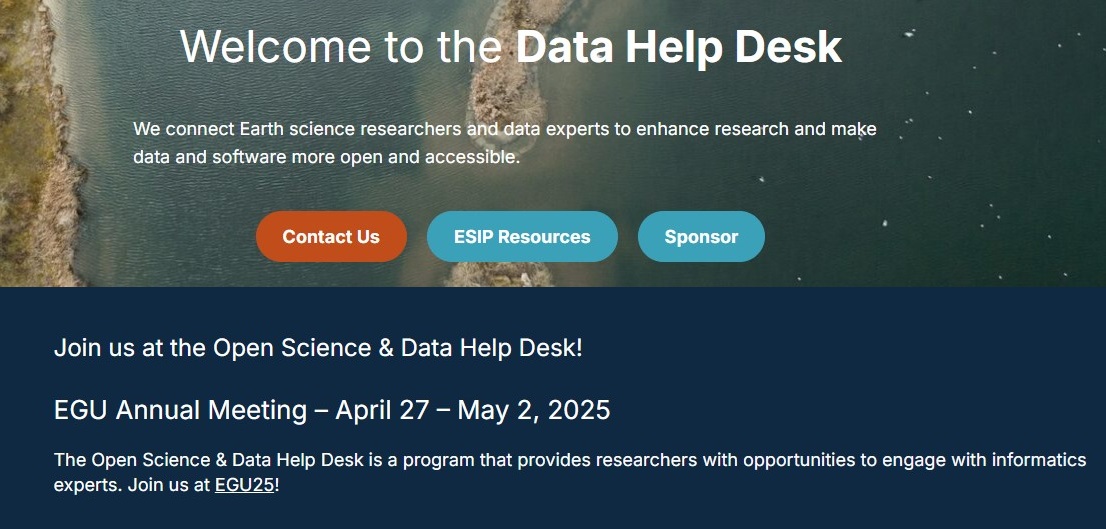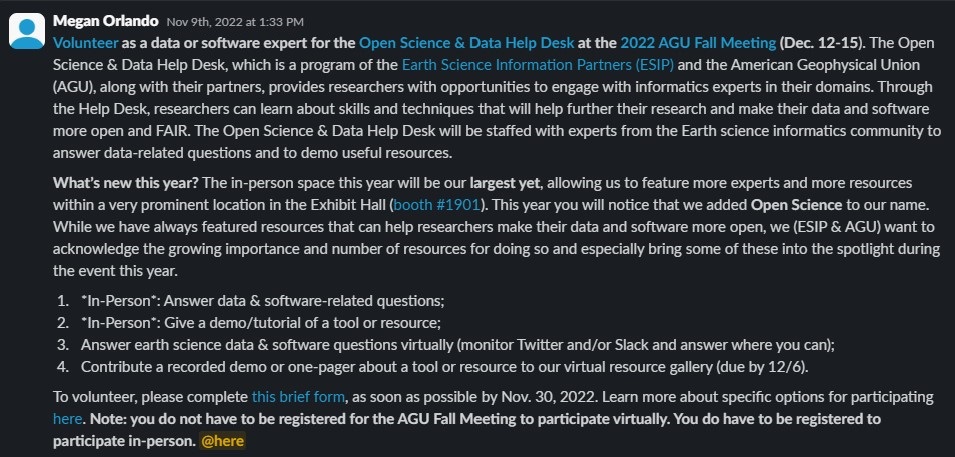Advertising & Promotion
Getting the word out about your Data Help Desk is crucial. If attendees don’t know it exists or what it’s for, they won’t come! Successful outreach requires more than a few social media posts—it means planning ahead, using multiple channels, and working closely with the conference organizers to make sure the Help Desk is visible in official materials, platforms, and communications.
This page offers guidance, examples, and templates to help you promote the Help Desk effectively.
DHD Website
Before beginning any outreach, it’s useful to have a central online location that you can point people to. This page should provide key details about the Help Desk—what it is, when and where it will be available at the upcoming event, and how people can engage with it.
The central ESIP Data Help Desk page serves as our home base. It shows where upcoming Help Desks are planned, includes background on the program, and often links out to relevant resources. That said, if the conference organizers are willing, having a Help Desk page or listing on the official conference website is extremely valuable. This ensures visibility within the context of the event and helps attendees who may not be familiar with the Help Desk understand why they should visit. Ideally, this listing should include:
- A short description of the Help Desk and what attendees can expect
- The booth number, location, and hours of operation
- A few example questions or topics the Help Desk can assist with
- A link to the ESIP DHD page or any featured resources

Where to Promote
Social Media
Social media is one of the fastest ways to build awareness for the Data Help Desk. Use platforms like Twitter/X, BlueSky, and LinkedIn to share timely updates and encourage engagement. You can post general reminders, highlight a different topic each day, or amplify your partners’ posts. Tag collaborators to broaden your reach and always include relevant hashtags like #DataHelpDesk and the conference tag.
When crafting posts, go beyond simply announcing the Help Desk—make the value clear. Highlight what attendees can learn, who they might meet, or what kinds of questions they can ask. For example:
“Not sure where to find data to back up your next paper? The #DataHelpDesk at #AGU23 is here to help. Come by Booth 1423!”
“Have questions about publishing and sharing your data? The #DataHelpDesk is open this week at #AGU23—visit Booth 1423.”
Sharing links to demos, one-pagers, and tools makes your posts even more actionable. We often use shortened URLs (like bit.ly/DataHelpAGU23) to save space and keep posts clean, especially on platforms with character limits.
Example social media posts are available.
Email remains one of the most reliable ways to spread the word about the Data Help Desk—especially through newsletters and listservs that your target audience already reads.
ESIP regularly includes Help Desk blurbs in its community newsletter, and many conferences offer similar opportunities through pre-event emails, daily digests, or partner communications. Check whether the conference has an attendee newsletter or exhibitor communication stream and ask about including a short announcement.
Institutional and community listservs are another key channel. These may be hosted by research groups, data repositories, academic departments, or discipline-specific communities. Keep your message concise and focused on what attendees will gain by stopping by or engaging online.
If you’re not sure where to start, we’ve put together email templates that you can copy, customize, and reuse.
Blog Posts
A well-timed blog post is a great way to introduce the Data Help Desk to a wider audience—especially those who may be new to it. Blog posts can then be shared and are easily repurposed for email newsletters and social media.
If the conference organizer has a blog or accepts guest content, that’s an ideal place to post. It ensures visibility within the event’s existing communication channels. If that’s not an option, consider posting through a partner organization’s blog or your own institution’s site.
These posts don’t need to be long—400–600 words is enough to provide context and generate interest. We’ve provided a few blog templates and examples to help get you started.
Slack
Slack can be a useful channel for both organizing and promoting the Data Help Desk. If you’re part of the ESIP Slack workspace, the #datahelpdesk-experts channel is the central spot for coordination—sharing updates, flagging questions, and checking in with other volunteers. It’s especially helpful during the event for keeping communication quick and informal.
If the conference you’re supporting has its own Slack workspace, look for general channels or topical threads where attendees are likely to see your message. A short post letting people know where the Help Desk is, what kind of support you’re offering, and how they can participate—either in person or online—can drive traffic and engagement.

Conference Materials
Having a presence in official conference materials is one of the most effective ways to ensure attendees know about the Data Help Desk. These are often the first places people go to plan their time whether it’s a printed program, a mobile app, or a digital platform like Sched, Fourwaves, or an internal attendee portal. If the conference uses a community platform to connect participants, that’s also a good place to post reminders or direct people to your resources.
Ask conference organizers to include the Help Desk in the official schedule or exhibitor listings. At a minimum, this should include the booth number, hours, and a short description. If there’s a way to link out to more information—either your Help Desk page or a resource gallery—include a short URL or QR code.
General Tips
- Planning your outreach ahead of time makes everything easier. Even if you don’t have all the final details—like booth number or the full demo schedule—you can begin promoting the Help Desk early and update posts as needed.
- A good time to start advertising is around when presentation abstracts are due. That’s typically when conference buzz starts to build and when you’ll also begin recruiting demoers and volunteers.
- It’s helpful to create a simple content plan and use a scheduling tool like Buffer, Hootsuite, or TweetDeck to prepare your posts in advance.
- If you’re planning live demos or themed days (e.g., publishing support, data management tools), promote those time slots directly. Giving attendees something specific to look forward to can boost engagement and booth traffic.
 Data Help Desk Playbook
Data Help Desk Playbook